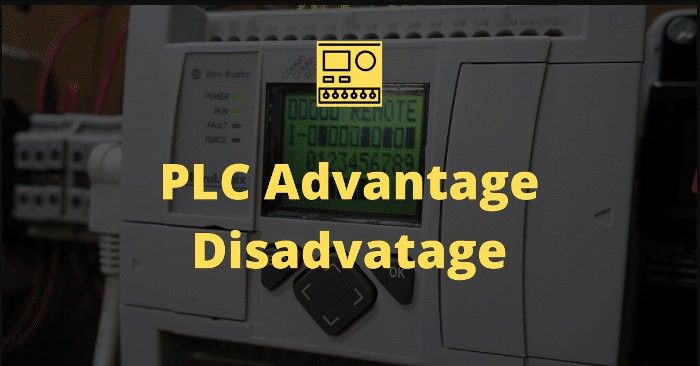PLCs are advantageous in many circumstances. But you should be aware of the disadvantages of PLC as well. This article shows the advantages and disadvantages of PLC.
PLCs offer many advantages, including reliability, straightforwardness, versatility, cost-effectiveness, and safety. There are disadvantages of PLC, too – cross-manufacturer incompatibility, automatic start-ups after power restoration, and the fact that only a single program can be run simultaneously.

Interested in learning more about PLCs and how they can benefit your business or industry? Then this article is for you. We provide a comprehensive overview of the advantages and disadvantages of PLCs and some context for how they compare to other control systems. Let’s take a look.
See Also: How To Display Time In HTML Using JavaScript?
Table of Contents
Description PLC
A digital computer called a PLC, or “programmable logic controller,” is used in industrial control systems to automate operations and manage machinery.
The Advantages and Disadvantages of PLC
The following are PLC’s advantages and disadvantages:
| Advantages | Disadvantages |
| Reliability | Initial Cost |
| Versatility | Programming skills |
| Ease of use | Limited flexibility |
| Cost Effectiveness | Complexity |
| Safety | Maintenance |
Advantages of PLC
Here are a few advantages of PLC
Reliability
PLCs are dependable and long-lasting and may run for extended periods without maintenance.

They are, therefore, perfect for usage in manufacturing and industrial environments where continuous functioning is crucial.
Versatility
PLCs also control a wide range of machinery and operations. So, they apply to various industries, including manufacturing, transportation, and energy generation.
Ease of use
PLCs may be straightforward programming languages and are user friendly.

As a result, users with different technical backgrounds and ability levels can use them.
Cost-Effectiveness
Over the long haul, PLCs are typically more cost-effective than control systems. They are to automate processes and do away with the requirement for manual labor, which can result in cost savings.
Safe
PLCs are also used to guarantee both worker and equipment safety. For instance, they might be set up to turn off machinery in the event of a crisis or breakdown, which could help to avoid accidents.
See Also: Python For Scientific Computing: Everything You Need To Know
Disadvantages of PLC
Here are a few disadvantages of PLC:
Initial cost
PLC installation and purchase costs can be high, particularly for more extensive or intricate systems. For some businesses, especially those with tight finances, this might be a Hindrance.
Programming skills
Programming knowledge is necessary to use PLCs efficiently.

As a result, businesses that lack essential programming expertise may need to recruit more workers or outsource the programming work, which can be costly.
Limited flexibility
PLCs control particular machinery and processes. They may not be as adaptable as other control systems, but they can perform various functions.
Complexity
PLCs can be complicated systems, particularly for more sophisticated or large-scale applications.

Because of this, they could be challenging for users who are unfamiliar with them to comprehend and use.
Maintenance
PLCs must undergo routine maintenance to guarantee proper operation. This may cost money, take time, and require specialized knowledge and abilities.
Some other Advantages
There should be a benchmark against which PLC can be compared. In this instance, we are contrasting PLC with relays and DCS (Distributed Control System).
PLC’s advantages over relays include
- PLC improves the automation system’s precision, flexibility, and dependability.
- PLC software has strong programming skills and flexibility. Also, you can quickly change an existing program at any moment.
- PLC programming is simple to develop and comprehend. PLCs use a variety of programming languages. Ladder diagram (LD) PLC programming is the simplest of them all.
- The PLC can easily connect and communicate with the computer. PLC doesn’t require much room. It often occurs in tiny sizes, particularly in compact PLCs.
- The most significant benefits of competing technologies are quick operation (no booting time). Little maintenance is required with PLC, and it provides the opportunity for supervisory control.
- The PLC system requires less and more straightforward wiring than other systems. Development is simpler with a modular PLC than with a compact PLC.
- In a modular PLC, modification is feasible. An already implemented design can be readily modified and responds quickly to connected systems.
- It can execute an action using a control system that is basic or complicated. With the use of PLC programming instructions, it can perform good computational functions.
- PLC scan times are quick (about 10-15 ms for compact PLC). To complete any work, relatively little operation time is needed.
- Building a small project is suitable for PLC because it requires less time.
Some other Disadvantages
Compared to the benefits, there are a few drawbacks.PLC drawbacks include
- In a small PLC, one program can be run at once.
- Regarding PLCs, we cannot combine software and components from one PLC manufacturer with those from another.
- PLC starts up automatically after power is restored. To prevent harm, you can program the output to switch to the fail-safe mode.
FAQs
The advantages of using PLC are:- It is cost-effective and easy to use. Can run for longer periods without maintenance Safe to use Can control a wide range of operations at a time, etc.
There are diverse uses of PLCs, but they are commonly used in civil applications. They are used in elevators, washing machines, traffic signals, etc
Some drawbacks of PLC include the following:- Need of programming language to use efficiently The initial cost of purchase and installation of PLC is high It can be complex for large-scale applications, etc. What are the advantages of using PLC?
What is the application of PLC?
What are the disadvantages of PLC?
Conclusion
We did our best to give you the most up-to-date information possible about the advantages and disadvantages of PLC. We hope that we can assist you. Thank you
See Also: Python Round() Function: Complete Tutorial